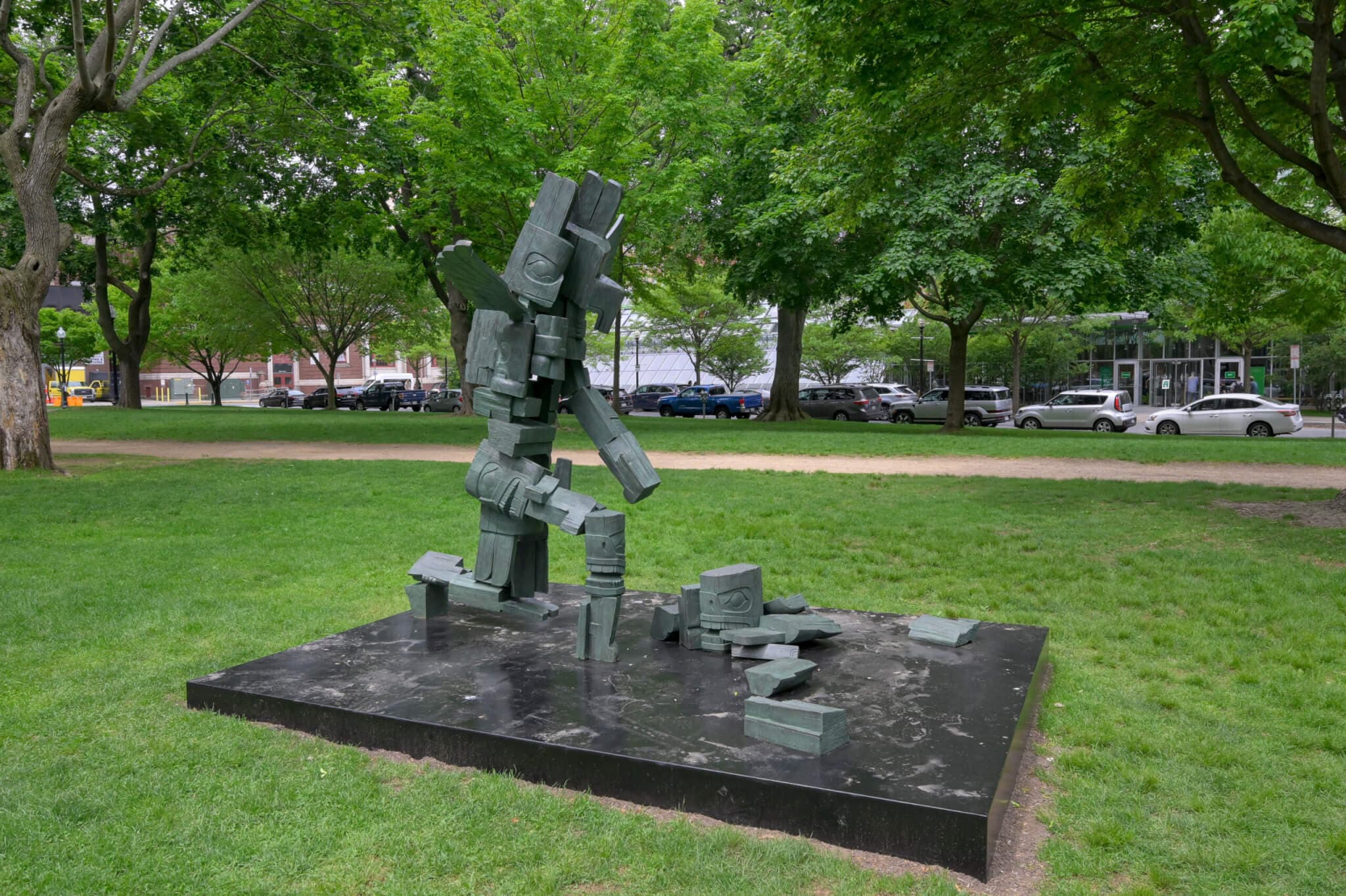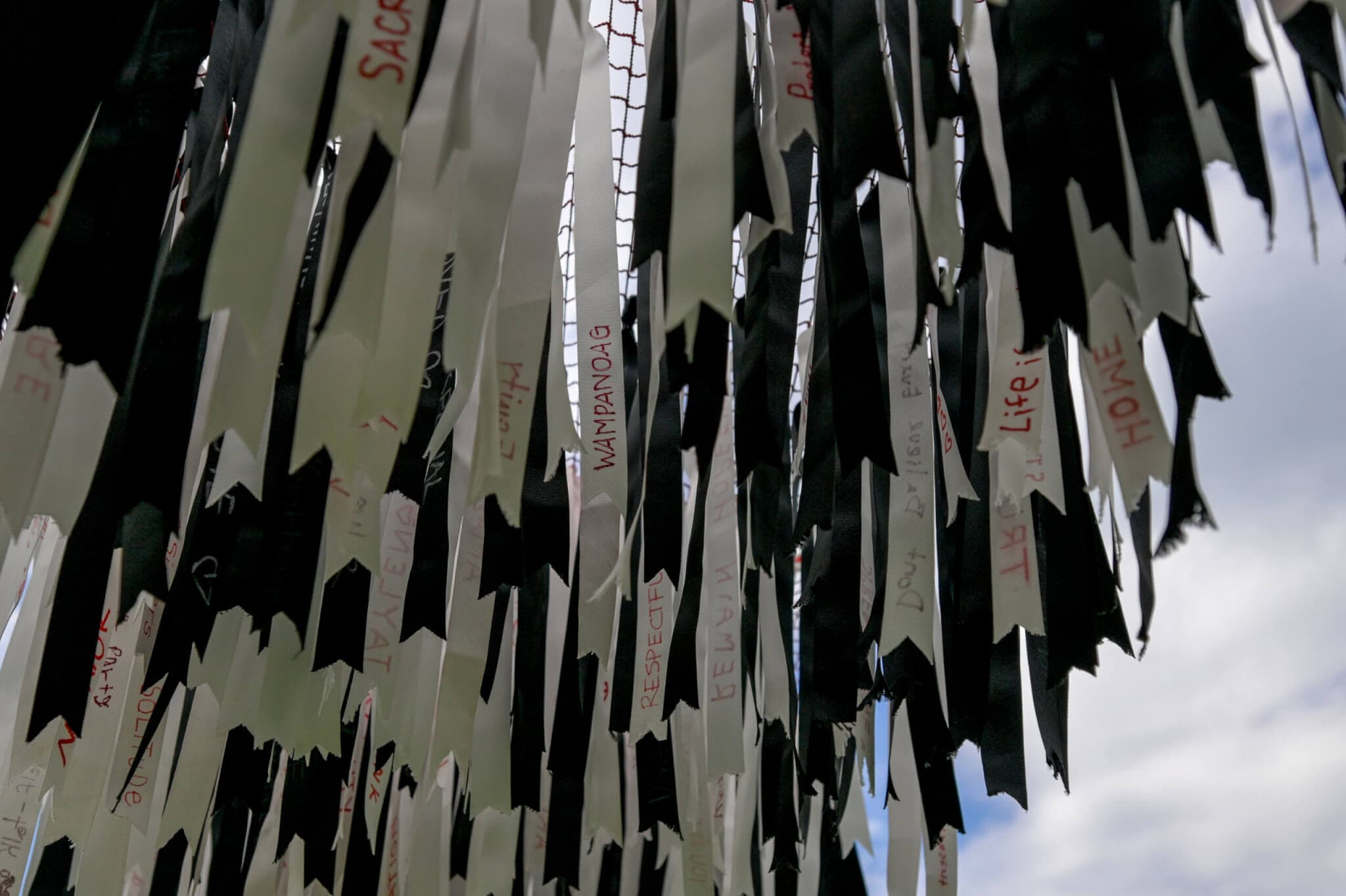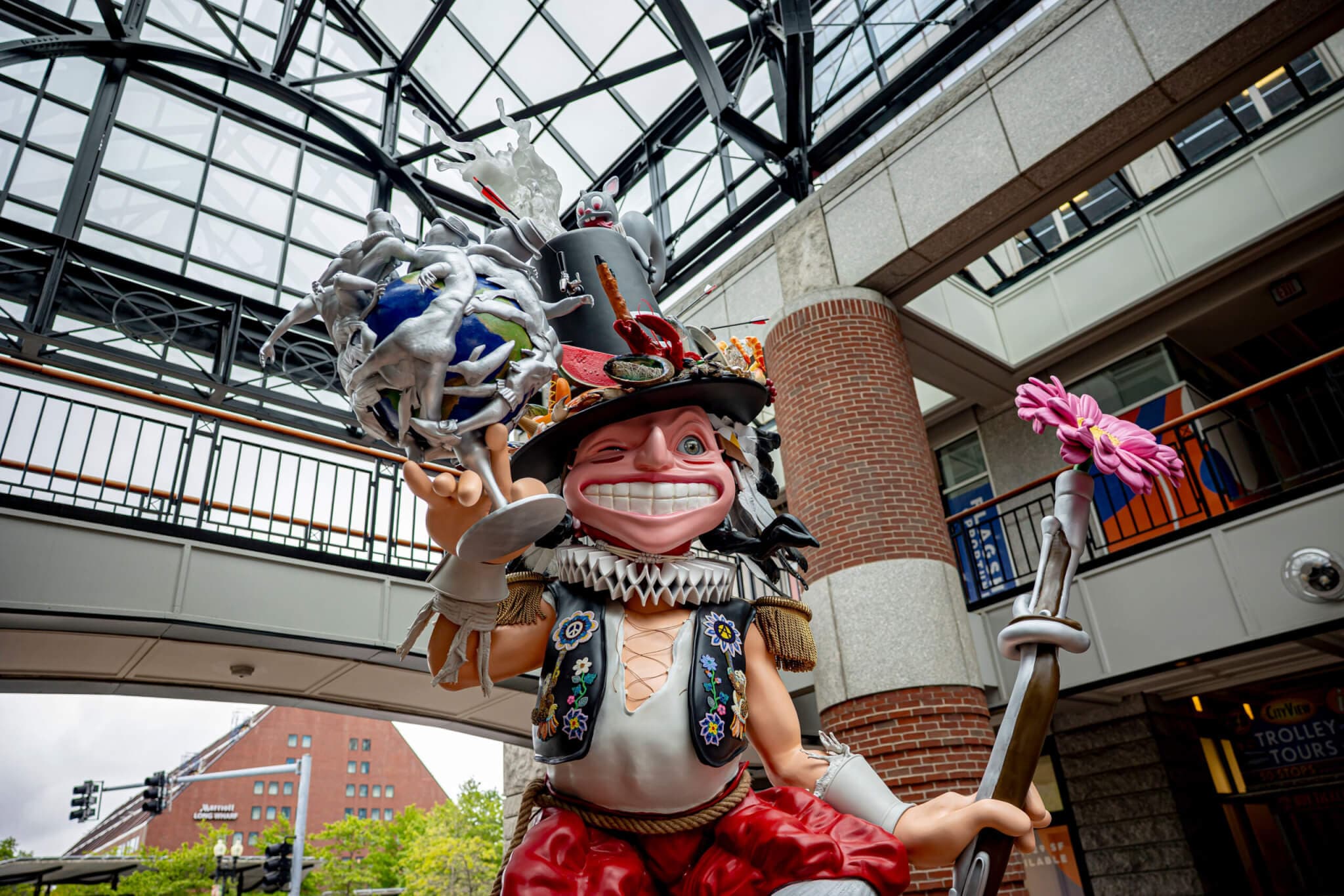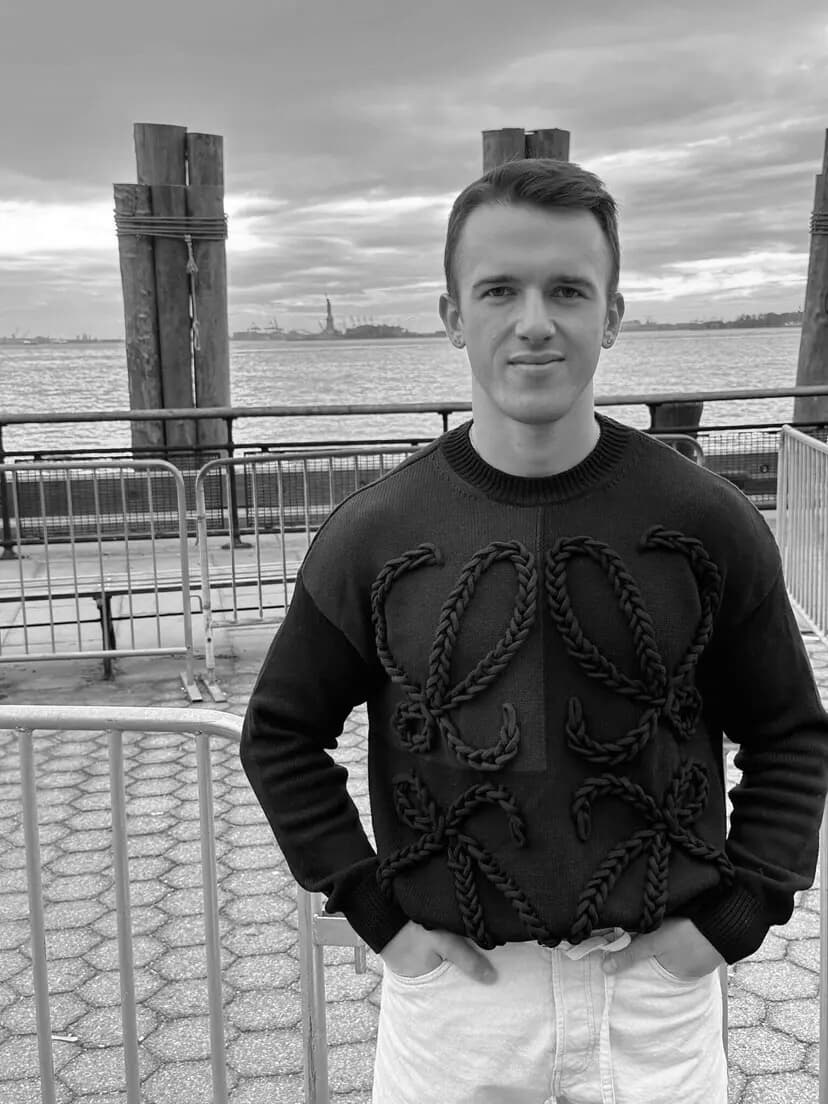One quarter of the Boston Public Art Triennial’s sixteen artists are Native—but none hail from New England. The timing of this Indigenous surge across Boston’s art scene looks like progress, but the redwashing may be a red herring distracting from questions of authentic representation. Perhaps the premier academic city is trying to atone for its colonial monuments and other provincial embarrassments.
By bringing these works to Boston, Nicholas Galanin, New Red Order (NRO), Alan Michelson, and Cannupa Hanska Luger attempt to reckon with—or perhaps rebrand—Boston’s deeply colonial and prosaic identity. The contrast between its brutal history and placid, collegiate present emerges through these artists’ interventions, which cut through Boston’s sanitized self-presentation to expose ongoing colonial structures.
On May 22, the ribbon cutting event for the Triennial was relocated around the corner from Galanin’s installation outside of the Isabella Stewart Gardner Museum to MassArt Art Museum, where his second piece, Aáni yéi xat duwasáakw (I am called Land) (2025), fills the second floor with a box drum suspended and held by rope. During the event, against Galanin’s fetus-marked drum, whose soft, rhythmic heartbeat is powered by a robotic arm, the optics turned accidentally profound—new life weaponized for old theater.

Nicholas Galanin, I think it goes like this (pick yourself up), installation view, Boston Public Art Triennial, May 22–October 31, 2025. Photo by Faith Ninivaggi. Courtesy of the Boston Public Art Triennial.
Outside of the museum, in the adjacent Evans Way Park, Galanin’s bronze sculpture recovers against all odds from colonial onslaught. In I think it goes like this (pick yourself up) (2025), dismantled totem pieces reassemble themselves into a figure rising from one knee—resilience as a literal instruction manual. His totem won’t settle, either. Where traditional Tlingít poles record lineage and events in static wood, these bronze pieces—settlers recognize only metal as monumental yet still powered by the tacit yet tenacious wood beneath—reconfigure themselves endlessly, a corrective to “Seward’s Folly.” William Seward, the US secretary who negotiated the purchase of Alaska in the nineteenth century, got a monument in Madison Square Park; the Tlingít got erasure. The folly wasn’t the 1867 purchase—it was imagining Indigenous people came with the deed.
Galanin’s kinetic works pulse with restless energy—totems that refuse to stay unbuilt, drums that beat without human hands. This frenetic quality suggests survival as perpetual motion, cultural persistence as literal movement. Where genocide demands stillness, his sculptures insist on animation.
Across town, Cannupa Hanska Luger employs a different strategy. The buffalo refuses to buffalo. Luger’s Transmutation (2025) substitutes steel ceremony for bronze tyranny and community ribbons for imperial silence. Like Andrea Carlson, Marie Watt, and Raven Halfmoon, he’s reverse-engineering the monument—making it serve the living instead of the dead.

Cannupa Hanska Luger, Transmutation, detail, 2025. On view at University of Massachusetts Boston, Boston Public Art Triennial, May 22–October 31, 2025. Photo by Faith Ninivaggi. Courtesy of the Boston Public Art Triennial.
Transmutation follows last year’s Attrition (2024), Luger’s buffalo cenotaph at New York City Hall. Wall Street’s bull charges forward; Luger’s buffalo remembers backward. The emergent ten-foot-long skeletal sculpture with an ash patina confronts Wall Street’s bronze bull as a specter of extermination—its very materiality invoking the millions of buffalo burned to ash across the plains. Where the bull celebrates accumulation, the buffalo’s skeletal form bears witness to systematic destruction. The math was simple: call them threats, kill 60 million, use their bones to whiten sugar. Turn obstacles into infrastructure. But Transmutation spurns that calculus. The ribbons tell a different story. Silk streamers arriving with European traders, transformed into ribbon shirts and skirts for powwow dances, now flutter as something else entirely. What once facilitated trade now brokers healing. Viewers sway unconsciously as the ribbons move, pulled into the buffalo’s rhythm. It’s the opposite of what monuments usually do: Instead of making you feel small, it makes you part of something larger. Do land acknowledgments move people like this?

New Red Order, Material Monument to Thomas Morton (Playing Indian), installation view at Marketplace Center, Boston Public Art Triennial, May 22– October 31, 2025. Photo by Caitlin Cunningham. Courtesy of the Boston Public Art Triennial.
New Red Order’s Material Monument to Thomas Morton (Playing Indian) (2025) interrogates performativity in another part of the city. A campy lampoon of overzealous Indigenous allies, the white-skinned figure with an oversized head and smile, a body adorned with a mashup of colonial garb, a feather headdress, and a hippie patch vest: allyship gone wrong. Positioned within the elite academic hub that is Boston, the statue suggests premier education doesn’t cure Indigenous ignorance. Pedigree isn’t everything. The technology fits the critique: 3D printed, but the Native dimension is missing. The irony runs deeper—from Elizabeth Warren’s DNA test to Thomas Morton’s Merrymount: white figures performing Native solidarity while operating within colonial structures. Morton, the statue’s namesake, was condemned by Puritans for the opposite problem—overzealously embracing the Wampanoag, Massachusetts’ local tribe. Exiled from Plymouth Colony for selling firearms and alcohol—though, firewater didn’t do Native people any favors—and promoting miscegenation, Morton founded an egalitarian colony called Merrymount. But equality within colonialism is still oppression for the Wampanoag.
It’s a pattern NRO knows well: well-meaning white engagement that ultimately centers white comfort over Native sovereignty. Their moniker itself mocks the Improved Order of Red Men, an elite group including politicos Warren G. Harding and Theodore Roosevelt, who would dress in redface and perform “sacred rituals” demonstrating brotherhood and a profound belief in Manifest Destiny. A volte-face of settler desire, NRO’s members Adam Khalil, Zack Khalil, and Jackson Polys have produced other satirical works like Give it Back (2020), which features an LED display of the New Red Times Magazine—the front side depicts an upside-down One World Trade with googly eyes and the words “Tired of Living on Stolen Land? Give It Back”; on the flipside, sanguine paint redwashes the planet.
These works sketch blueprints for an Indigenized future.

Alan Michelson (American, born in 1953), The Knowledge Keepers: Andre, 2024. Bronze and platinum gilt. Courtesy the artist. Commissioned by the MFA for the Huntington Avenue Entrance Commission. Photograph © Museum of Fine Arts, Boston.

Alan Michelson (American, born in 1953), The Knowledge Keepers: Julia, 2024. Bronze and platinum gilt. Courtesy the artist. Commissioned by the MFA for the Huntington Avenue Entrance Commission. Photograph © Museum of Fine Arts, Boston.
Alan Michelson completes the quadrumvirate of influential Native artists involved in the Triennial. His offering: The Knowledge Keepers (2024), two bronze-cast, silver-gilded statues dedicated to celebrating local Indigenous artists and leaders. One depicts a Native matriarch, her left arm akimbo, her right elevated with an eagle feather fan and modeled after Aquinnah Wampanoag member Julia Marden. In life, she fashions her regalia from scratch, preserving techniques passed down through generations.The second statue represents Nipmuc descendant Andre StrongBearHeart Gaines, Jr., and depicts him reading a document in traditional clothes. Gaines builds wetus—traditional homes—and organizes for Native rights. Neither achieved fame through conquest or politics. They’re knowledge keepers, not empire builders.
This active, yet ordinary dyad structurally rejects the stoic individualism of Western monuments. Where bronze generals freeze moments of dominance, Michelson’s figures capture ongoing cultural work. The materials—bronze and silver—deploy monument language of permanence and value, but transform its meaning: Rather than commemorating conquest, these precious metals honor the continuity of Indigenous cultural practices and the sacred nature of daily care work.
Each of these monuments from the Triennial confront Boston’s formation and history directly. History and humor animate what monuments traditionally deaden. As a New Yorker from California, visiting New England feels like time traveling. Bostonians still celebrate the admiral of the ocean sea, still bear street names like Colonial Way without irony. These artists crack the amber. What emerges isn’t nostalgia but reckoning, contesting the turgid, Olympian ethos of Western monuments.






